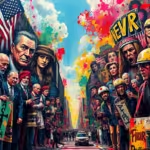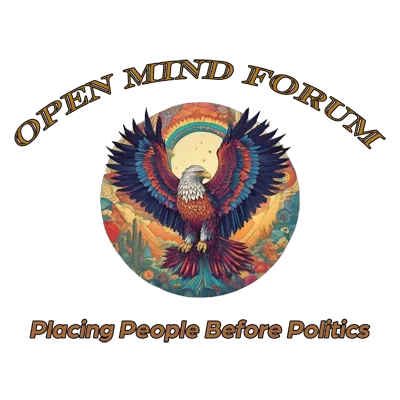Billionaires and Their Serfs
The Rise of Xenophobia and Class Control
Billionaires and Their Serfs as an idea was first entertained when I read Slavoj Žižek’s brief but brilliant book First as Tragedy Then as Farce quoted below.
In First as Tragedy, Then as Farce, Slavoj Žižek writes, “We grant ourselves permission to applaud African and East European sportsmen, Asian doctors, Indian software programmers. We

don’t want to kill anyone; we don’t want to organize a pogrom. But we think the best way to hinder the always unpredictable actions of violent anti-immigration protests is to organize ‘reasonable anti-immigrant protection.’” This sentiment reflects how modern xenophobia operates under a mask of “reasonable” racism. Western governments reject overt populist bigotry while endorsing policies that appease nationalist fears. This has become especially evident in the United States and Western Europe as hard-core nationalism rises.
This surge in xenophobia is not just the result of bigoted ideologies but a strategy of class control orchestrated by the ruling elite—billionaires and their serfs. Late-stage capitalism has created an oligarchical ruling class, raking in massive profits while manipulating the serf class. As jobs disappear through globalization, free trade, and deregulation, anger rises—but that anger is often misdirected. Instead of aiming at the billionaires responsible, working-class people turn against their neighbors: immigrants, people of color, and anyone who is “other.”
Billionaires and Their Serfs: The Reagan Revolution Dismantling Workers’ Power
This shift in public sentiment began under Ronald Reagan’s presidency, a critical moment for billionaires and their serfs. Reagan’s administration worked tirelessly to dismantle unions, strip workers of their power, and end the Fairness Doctrine, which ensured balanced media coverage. By eroding government oversight, Reagan enabled corporations to escape accountability, especially when it came to workers’ rights and safety.
One of Reagan’s most significant moves was his handling of the 1981 air traffic controllers’ strike. After the Professional Air Traffic Controllers Organization (PATCO) called for a strike over better working conditions and higher wages, Reagan fired over 11,000 workers who refused to return to work. This marked a decisive blow against organized labor, signaling to corporations that they had free rein to undermine unions without fear of government intervention. The weakening of unions opened the door to the offshoring of American jobs, accelerating the process of globalization.
Reagan’s administration also played a key role in promoting free-market policies that led to the outsourcing of jobs to countries with cheaper labor. The introduction of trade agreements like the General Agreement on Tariffs and Trade (GATT) and the push for corporate tax cuts further incentivized American companies to relocate their manufacturing operations overseas. The consequences were devastating for the American working class, as entire industries—steel, textiles, and electronics—moved to countries where labor was unprotected and poorly paid.
Billionaires and Their Serfs: The Fairness Doctrine and the Media’s Role
The 1987 repeal of the Fairness Doctrine, a policy that required broadcasters to present opposing viewpoints on controversial issues, further exacerbated the problem. This move, supported by the Reagan administration, paved the way for the rise of partisan media, notably Fox News. Without the Fairness Doctrine, media moguls like Rupert Murdoch were free to use their platforms to propagate fear, misinformation, and xenophobia, fueling the divisions that serve the interests of billionaires and their serfs.
Fox News, owned by Australian billionaire Rupert Murdoch, became a megaphone for the ruling class, diverting attention away from corporate greed and focusing on “enemies” like immigrants, people of color, and left-wing activists. This tactic distracted working-class Americans from the real issues plaguing their lives: job loss, stagnant wages, and the erosion of labor rights. Billionaires and their serfs thrive on this division, ensuring that the serf class directs their anger at fellow workers instead of the wealthy elites who profit from their misery.
Billionaires and Their Serfs: Globalization, NAFTA, and Job Loss
Under the administration of Bill Clinton, neoliberal policies became further entrenched. The North American Free Trade Agreement (NAFTA), signed into law in 1994, was hailed as a victory for free trade. However, it resulted in the offshoring of hundreds of thousands of manufacturing jobs, especially in the Midwest. Factories closed, and working-class Americans were left with

fewer job opportunities, lower wages, and reduced benefits.
NAFTA wasn’t the only policy that hurt workers. The Clinton administration also pushed for financial deregulation, culminating in the repeal of the Glass-Steagall Act in 1999, which had separated commercial and investment banking. This move contributed to the 2008 financial crisis, when reckless Wall Street speculation and predatory lending practices plunged millions into foreclosure, unemployment, and financial ruin. Once again, it was billionaires and their serfs who benefited, as massive bailouts saved the financial institutions responsible, while ordinary Americans suffered the consequences.
Billionaires and Their Serfs: Supreme Court Decisions: Reinforcing Corporate Power
Court decisions during this era further entrenched the power of the ruling class. In 2010, the Supreme Court’s ruling in Citizens United v. FEC allowed unlimited corporate spending in elections, cementing the influence of billionaires and their serfs in politics. Corporations and the ultra-wealthy could now effectively buy elections, ensuring that their interests were protected at the expense of the broader population. This decision is a prime example of how the legal system, meant to uphold fairness, instead works to protect the wealthy few.
Billionaires and Their Serfs: The Endless War on the Working Class
The rise of Donald Trump marked the culmination of decades of neoliberal policies. Trump, a billionaire who positioned himself as a populist, capitalized on the frustrations of working-class Americans who had been left behind by globalization and job loss. His rhetoric targeted immigrants and minorities, echoing the “reasonable” racism Žižek describes. By focusing on border walls and “America First” policies, Trump diverted attention from the real cause of working-class despair: the economic policies of billionaires and their serfs.
The COVID-19 pandemic further exposed the inequalities in the system. While millions of Americans lost their jobs, homes, and access to healthcare, the wealth of billionaires soared. Jeff Bezos, Elon Musk, and other members of the ruling class saw their net worth skyrocket, while essential workers—many of whom were people of color and immigrants—faced unsafe working conditions and inadequate pay.
Billionaires and Their Serfs: The Fear of the Rich
Why do we fear the rich? The answer lies in their near-total control over our lives. Billionaires and their serfs have immense power, not just in terms of wealth but in shaping public policy, controlling media narratives, and influencing elections. They have successfully turned the serf class against itself, using fear of the “other” to distract from the real issue: the concentration of wealth and power in the hands of a few.
This fear is compounded by the propaganda machines that billionaires control. Fox News, Sinclair Broadcasting, and other media outlets push narratives that vilify immigrants, minorities, and progressive policies, while portraying billionaires as job creators and saviors of the economy. The result is a divided populace, with the working class internalizing the prejudices of their oppressors.
Conclusion: Reclaiming Power
The solution lies not in blaming our neighbors but in recognizing that billionaires and their serfs are the true culprits. We must reject their propaganda and organize to reclaim our power. Unions, once a formidable force for workers’ rights, need to be revitalized. Education is critical in this process. By creating spaces where the working class can learn about the forces that exploit them, we can shift the narrative and begin to fight back against the billionaire class.
Sources Cited
Chomsky, N. (1999). Profit over people: Neo-liberalism and global order. Seven Stories Press.
Reagan, R. (1982). The Reagan Diaries. HarperCollins.
Smith, J. (2010). Who stole the American dream? Crown.
Supreme Court of the United States. (2010). Citizens United v. Federal Election Commission, 558 U.S. 310.
Žižek, S. (2009). First as tragedy, then as farce. Verso.
Suggestions for Further Reading
- Noam Chomsky – Profit Over People: Neo-liberalism and Global Order
Chomsky critiques the rise of Neo-liberalism and its devastating effects on democracy and the working class.
- Naomi Klein – The Shock Doctrine: The Rise of Disaster Capitalism
Klein explores how governments and corporations exploit crises to impose neoliberal policies on the public.
- Joseph Stiglitz – Globalization and Its Discontents
Stiglitz analyzes how globalization has disproportionately harmed developing nations and the working class.
- Barbara Ehrenreich – Nickel and Dimed: On (Not) Getting By in America
Ehrenreich exposes the struggles of low-wage workers in America, a direct consequence of neoliberal policies.
- Chris Hedges – America: The Farewell Tour
Hedges provides a scathing critique of the decline of American society under the weight of corporate greed.
- Thomas Piketty – Capital in the Twenty-First Century
Piketty examines the growing wealth inequality and its long-term implications for democracy.
- Paul Krugman – The Conscience of a Liberal
Krugman argues for a return to New Deal-era policies to combat the negative effects of Neo-liberalism.
- Arlie Hochschild – Strangers in Their Own Land: Anger and Mourning on the American Right
Hochschild investigates the rise of right-wing populism and the misdirected anger of the working class.
- Robert Reich – The System: Who Rigged It, How We Fix It
Reich offers a detailed analysis of how the American economy has been rigged in favor of the wealthy few.
Disclaimer: The images and videos in this post are AI-generated creations, intended purely for illustrative and conceptual purposes. They are not real-life representations and should not be interpreted as such. Their sole purpose is to offer a visual means of exploring the topics discussed in this post.




